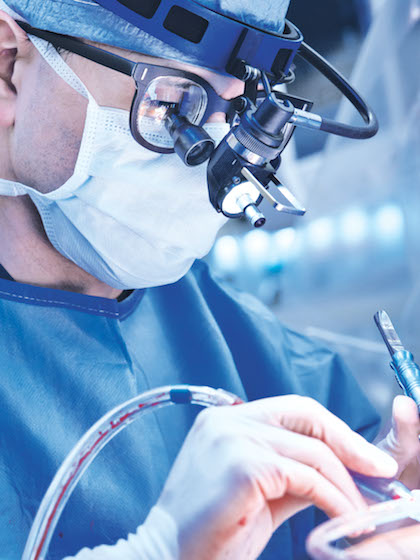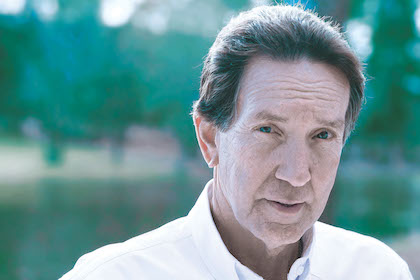A minimally traumatizing surgery for a maximum-risk heart

Seven percent. That’s the percentage of the blood in Tommy Lloyd’s heart that flowed through his aorta with each squeeze of his heart. For a healthy heart of someone in their 60s, that number should be about 70 percent.
While most people have a three-part aortic valve that opens and closes to send blood from the heart to the body, Mr. Lloyd was born with a two-part valve, which tends to stiffen and wear out earlier. By 2016, when Mr. Lloyd was 65, his heart condition had reached that critical point.
In January 2017, this medical problem led him to Dr. Neelan Doolabh, Associate Professor of Cardiovascular and Thoracic Surgery at UT Southwestern, who specializes in a rare minimally invasive procedure for valve replacement that reduces the trauma of heart surgery.
Dr. Doolabh is one of only a handful of surgeons in the world who performs valve repairs, valve replacements, and other heart procedures without cutting into any bone – a departure from typical heart surgeries that require removal of the breastbone or ribs.
Dr. Doolabh was recruited to UT Southwestern because of his expertise in this specific surgery, which, performed through a small incision, is technically much more demanding and consequently difficult to teach and master. Patients have come from across Texas and the United States to UT Southwestern for this procedure; one patient even came from Saudi Arabia to see Dr. Doolabh.
Because there are so few surgeons trained in this specialized technique, it accounts for less than 1 percent of aortic valve replacement surgeries. For people like Mr. Lloyd, it’s a critical option to have. Fortunately for him, UT Southwestern had the resources he needed – and just a few hours from his home in Longview, Texas.
“I’m going to spell this out for you,” Dr. Doolabh told Mr. Lloyd. “We can replace the valve without problem, but your heart is so weak it’s going to be hard restarting your heart after removing you from the heart-lung machine.”

Rather than making the more traditional 10-inch vertical incision down the center of the chest to access the heart, Dr. Doolabh recommended the minimally invasive approach, which requires a less than 2-inch incision between the ribs. Almost all patients in need of a valve replacement are good candidates for the technique – which Dr. Doolabh has been performing for a decade – but it’s especially valuable for patients who are older, obese, or have multiple health issues.
“It was terrifying to be told that I was that ill,” said Mr. Lloyd, whose surgery was completed in early 2017 at William P. Clements Jr. University Hospital. “But I told my surgeon I would rather flame out than fade away.”
Dr. Doolabh and the surgical team took just two hours to replace the damaged aortic valve, and when it came time for Mr. Lloyd’s heart to restart, it responded with a normal beat.
“I was so happy that I lived,” Mr. Lloyd recalled of awakening in his room. “The things I’d worried about – Who was going to take care of my wife? Would I see my three grandkids grow up? – it was all OK.”
Mr. Lloyd said he feels immense gratitude to Dr. Doolabh and the rest of the team, so much so that he felt inspired to make a gift to UT Southwestern for his excellent care. “When I was being discharged, Neelan [Doolabh] came by and we talked. I had tears in my eyes and I apologized for the tears,” Mr. Lloyd recalled. “He said, ‘It’s quite normal. You’ve been on the biggest roller coaster ride of your life.’”
Recovery for the traditional open-heart surgery approach can require six to eight weeks before patients can return to normal activities like driving. With the minimally invasive approach, people can often resume normal activities in about 10 days and – more importantly for Mr. Lloyd’s situation – the minimally invasive surgery is far less stressful on the body.
For Mr. Lloyd, who had always led an active life on his East Texas ranch, it meant doing many of the things that he hadn’t been able to do for quite a while before the valve replacement.
“Living on acreage, there’s always something to do. Building a fence. Taking down a pine tree and cutting it up to make a bonfire. Have I cut down any 90-foot trees lately? No, but that will be happening when it needs to be done,” he said.
“My goal was to turn my heart clock back 10 years, and that goal has been accomplished.”
